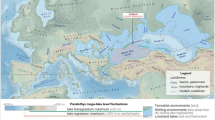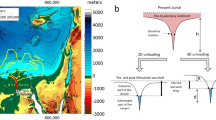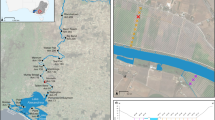Abstract
The Nile is the longest river on Earth and has persisted for millions of years. It has been suggested that the Nile in its present path is ~6 million years old, whereas others argue that it may have formed much earlier in geological history. Here we present geological evidence and geodynamic model results that suggest that the Nile drainage has been stable for ~30 million years. We suggest that the Nile’s longevity in essentially the same path is sustained by the persistence of a stable topographic gradient, which in turn is controlled by deeper mantle processes. We propose that a large mantle convection cell beneath the Nile region has controlled topography over the last 30 million years, inducing uplift in the Ethiopian–Yemen Dome and subsidence in the Levant Sea and northern Egypt. We conclude that the drainage system of large rivers and their evolution over time can be sustained by a dynamic topographic gradient.
This is a preview of subscription content, access via your institution
Access options
Access Nature and 54 other Nature Portfolio journals
Get Nature+, our best-value online-access subscription
$29.99 / 30 days
cancel any time
Subscribe to this journal
Receive 12 print issues and online access
$259.00 per year
only $21.58 per issue
Buy this article
- Purchase on Springer Link
- Instant access to full article PDF
Prices may be subject to local taxes which are calculated during checkout




Similar content being viewed by others
Data availability
Mantle and dynamic topography data analysed in this study were previously published in refs. 39,40. Additional data related to this paper have been deposited with the Geotop Research Centre on the Dynamics of the Earth System (https://www.geotop.ca/fr/recherche/donnees/geophysique). Crustal data and residual topography data are available in Zenodo with the identifier https://doi.org/10.5281/zenodo.3405359. Data from the Levant basin were previously published28 and are available at the website of the subsurface research lab at Geological Society of Israel (http://www.gsi.gov.il/eng/?CategoryID=239&ArticleID=598). Data on the evolution of the Ethiopian Plateau were published in ref. 32.
Code availability
Mantle-flow kernels employed to calculate mantle temperature structure and the dynamic topography predictions have been published in ref. 58 and deposited with the Geotop Research Centre on the Dynamics of the Earth System (https://www.geotop.ca/fr/recherche/donnees/geophysique). Figure 3 and Supplementary Fig. 3 were drawn using the Generic Mapping Tools (ref. 49, https://www.soest.hawaii.edu/gmt/).
References
Audley-Charles, M. G., Curray, J. R. & Evans, G. Location of major deltas. Geology 5, 341–344 (1977).
Potter, P. E. Significance and origin of big rivers. J. Geol. 86, 13–33 (1978).
Cox, K. G. The role of mantle plumes in the development of continental drainage patterns. Nature 342, 873–877 (1989).
Goudie, A. S. The drainage of Africa since the Cretaceous. Geomorphology 67, 437–456 (2005).
Garzanti, E., Andò, S., Vezzoli, G., Megid, A. A. A. & El Kammar, A. Petrology of Nile River sands (Ethiopia and Sudan): sediment budgets and erosion patterns. Earth Planet. Sci. Lett. 252, 327–341 (2006).
Shephard, G. E., Müller, R. D., Liu, L. & Gurnis, M. Miocene drainage reversal of the Amazon River driven by plate–mantle interaction. Nat. Geosci. 3, 870–875 (2010).
Salles, T., Flament, N. & Müller, D. Influence of mantle flow on the drainage of eastern Australia since the Jurassic Period. Geochem. Geophys. Geosyst. 18, 280–305 (2017).
Czarnota, K., Roberts, G. G., White, N. J. & Fishwick, S. Spatial and temporal patterns of Australian dynamic topography from River Profile Modeling. J. Geophys. Res. Solid Earth 119, 1384–1424 (2014).
Rudge, J. F., Roberts, G. G., White, N. J. & Richardson, C. N. Uplift histories of Africa and Australia from linear inverse modeling of drainage inventories. J. Geophys. Res. Earth 120, 894–914 (2015).
Paul, J. D., Roberts, G. G. & White, N. The African landscape through space and time. Tectonics 33, 898–935 (2014).
McDougall, I., Morton, W. H. & Williams, M. A. J. Age and rates of denudation of Trap Series basalts at Blue Nile Gorge, Ethiopia. Nature 254, 207–209 (1975).
Williams, M. A. J. & Williams, F. M. in The Sahara and the Nile (eds Williams, M. A. J. & Faure, H.) 207–224 (A. A. Balkema, 1980).
Burke, K. & Wells, G. L. Trans-African drainage system of the Sahara: was it the Nile? Geology 17, 743–747 (1989).
Pik, R., Marty, B., Carignan, J. & Lavé, J. Stability of the Upper Nile drainage network (Ethiopia) deduced from (U–Th)/He thermochronometry: implications for uplift and erosion of the Afar plume dome. Earth Planet. Sci. Lett. 215, 73–88 (2003).
Abdelkareem, M., Ghoneim, E., El-Baz, F. & Askalany, M. New insight on paleoriver development in the Nile basin of the eastern Sahara. J. Afr. Earth Sci. 62, 35–40 (2012).
Stern, R. J. & Abdelsalam, M. G. The origin of the great bend of the Nile from SIR-C/X-SAR imagery. Science 274, 1696–1698 (1996).
Butzer, K. W. & Hansen, C. L. Desert and River in Nubia (Univ. Wisconsin Press, 1968).
Said, R. The River Nile: Geology, Hydrology and Utilization (Elsevier, 1993).
Issawi, B. & McCauley, J. F. in The Followers of Horus, Studies Dedicated to Michael Allen Hoffman 1944–1990 (eds Friedman, R. F. & Adams, B.) 121–138 (Oxford Univ. Press, 1992).
Talbot, M. R. & Williams, M. A. J. in The Nile—Origin, Environments, Limnology and Human Use (ed. Dumont, H. J.) 37–70 (Springer, 2009).
Gani, N. D., Abdelsalam, M. G. & Gani, M. R. Blue Nile incision on the Ethiopian Plateau: pulsed plateau growth, Pliocene uplift, and hominin evolution. Geol. Soc. Am. Today 17, 4–11 (2007).
Wainwright, G. A. Herodotus II, 28 on the sources of the Nile. J. Hellenic Stud. 73, 104–107 (1953).
Padoan, M., Garzanti, E., Harlavan, Y. & Villa, I. M. Tracing Nile sediment sources by Sr and Nd isotope signatures (Uganda, Ethiopia, Sudan). Geochim. Cosmochim. Acta 75, 3627–3644 (2011).
Garzanti, E., Andò, S., Padoan, M., Vezzoli, G. & El Kammar, A. The modern Nile sediment system: processes and products. Quat. Sci. Rev. 130, 9–56 (2015).
Chumakov, I. S. in Desert and River in Nubia: Geomorphology and Prehistoric Environments at the Aswan Reservoir (eds Butzer, K. A. & Hansen, C. L.) 521–522 (Univ. Wisconsin Press, 1968).
Fielding, L. et al. The initiation and evolution of the River Nile. Earth Planet. Sci. Lett. 489, 166–178 (2018).
Macgregor, D. S. The development of the Nile drainage system: integration of onshore and offshore evidence. Petrol. Geosci. 18, 417–431 (2012).
Steinberg, J., Gvirtzman, Z., Folkman, Y. & Garfunkel, Z. Origin and nature of the Tertiary infilling of the Levant Basin. Geology 39, 355–358 (2011).
Schumer, R. & Jerolmack, D. J. Real and apparent changes in sediment deposition rates through time. J. Geophys. Res. Earth. 114, F00A06 (2009).
Sembroni, A., Molin, P., Pazzaglia, F. J., Faccenna, C. & Bekele, A. Evolution of continental-scale drainage in response to mantle dynamics and surface processes: an example from the Ethiopian Highlands. Geomorphology 261, 12–29 (2016).
Giachetta, E. & Willett, S. D. Effects of river capture and sediment flux on the evolution of plateaus: insights from numerical modeling and river profile analysis in the upper Blue Nile catchment. J. Geophy. Res. Earth 123, 1187–1217 (2018).
Sembroni, A., Faccenna, C., Becker, T. W., Molin, P. & Bekele, A. Long-term, deep mantle support of the Ethiopia-Yemen Plateau. Tectonics 35, 469–488 (2016).
Pik, R., Marty, B., Carignan, J., Yirgu, G. & Ayalew, T. Timing of East African Rift development in southern Ethiopia: implication for mantle plume activity and evolution of topography. Geology 36, 167–170 (2008).
Moucha, R. & Forte, A. M. Changes in African topography driven by mantle convection. Nat. Geosci. 4, 707–712 (2011).
Faccenna, C., Becker, T. W., Jolivet, L. & Keskin, M. Mantle convection in the Middle East: reconciling Afar upwelling, Arabia indentation and Aegean trench rollback. Earth Planet. Sci. Lett. 375, 254–269 (2013).
Ebinger, C. & Sleep, N. H. Cenozoic magmatism in central and east Africa resulting from impact of one large plume. Nature 395, 788–791 (1998).
Şengör, A. M. C. in Mantle Plumes: Their Identification through Time Vol. 352 (eds Ernst, R. E. & Buchan, K. L.) 183–225 (Geological Society of America, 2001).
Gvirtzman, Z., Faccenna, C. & Becker, T. W. Isostasy, flexure, and dynamic topography. Tectonophysics 683, 255–271 (2016).
Glišović, P. & Forte, A. M. A new back-and-forth iterative method for time-reversed convection modeling: implications for the Cenozoic evolution of 3-D structure and dynamics of the mantle. J. Geophys. Res. Solid Earth 121, 4067–4084 (2016).
Glišović, P. & Forte, A. M. On the deep-mantle origin of the Deccan Traps. Science 355, 613–616 (2017).
Capitanio, F. A., Faccenna, C. & Funiciello, R. The opening of Sirte basin: result of slab avalanching? Earth Planet. Sci. Lett. 285, 210–216 (2009).
Burke, K. The African plate. J. Afr. Earth Sci. 99, 341–409 (1996).
Avni, Y., Segev, A. & Ginat, H. Oligocene regional denudation of the northern Afar dome: pre- and syn-breakup stages of the Afro-Arabian plate. Geol. Soc. Am. Bull. 124, 1871–1897 (2012).
Van der Voo, R., Spakman, W. & Bijwaard, H. Tethyan subducted slabs under India. Earth Planet. Sci. Lett. 171, 7–20 (1999).
Faccenna, C., Jolivet, L., Piromallo, C. & Morelli, A. Subduction and the depth of convection in the Mediterranean mantle. J. Geophys. Res. Solid Earth 108, 2099 (2003).
Barazi, N. & Kuss, J. Southernmost outcrops of marine lower Tertiary carbonate rocks in NE-Africa (Gebel Abyad, Sudan). Geol. Rundschau 76, 529–537 (1987).
Laske, G., Masters, G., Ma, Z. & Pasyanos, M. Update on CRUST1.0—a 1-degree global model of Earth’s crust. EGU General Assembly Conf. 15, abstr. 2658 (2013).
Rowley, D. B. et al. Kinematics and dynamics of the East Pacific Rise linked to a stable, deep-mantle upwelling. Sci. Adv. 2, e1601107 (2016).
Wessel, P., Smith, W. H. F., Scharroo, R., Luis, J. & Wobbe, F. Generic Mapping Tools: improved version released. EOS Trans. AGU 94, 409–410 (2013).
Glišović, P., Forte, A. & Moucha, R. Time-dependent convection models of mantle thermal structure constrained by seismic tomography and geodynamics: implications for mantle plume dynamics and CMB heat flux. Geophys. J. Int. 190, 785–815 (2012).
Glišović, P. & Forte, A. M. Reconstructing the Cenozoic evolution of the mantle: implications for mantle plume dynamics under the Pacific and Indian Plates. Earth Planet. Sci. Lett. 390, 146–156 (2014).
Mitrovica, J. X. & Forte, A. M. A new inference of mantle viscosity based upon joint inversion of convection and glacial isostatic adjustment data. Earth Planet. Sci. Lett. 225, 177–189 (2004).
Glišović, P., Forte, A. M. & Ammann, M. W. Variations in grain size and viscosity based on vacancy diffusion in minerals, seismic tomography, and geodynamically inferred mantle rheology. Geophys. Res. Lett. 42, 6278–6286 (2015).
Katsura, T. et al. Olivine-wadsleyite transition in the system (Mg,Fe)2SiO4. J. Geophys. Res. Solid Earth 109, B02209 (2004).
Forte, A. M. & Peltier, W. R. The kinematics and dynamics of poloidal–toroidal coupling in mantle flow: the importance of surface plates and lateral viscosity variations. Adv. Geophys. 36, 1–119 (1994).
Simmons, N. A., Forte, A. M., Boschi, L. & Grand, S. P. GyPSuM: a joint tomographic model of mantle density and seismic wave speeds. J. Geophys. Res. Solid Earth 115, B12310 (2010).
Forte, A. M., Simmons, N. A. & Grand, S. P. in Treatise on Geophysics 2nd edn (ed. Schubert, G.) 853–907 (Elsevier, 2015).
Glišović, P. & Forte, A. M. Two deep-mantle sources for Paleocene doming and volcanism in the North Atlantic. Proc. Natl Acad. Sci. USA 116, 13227–13232 (2019).
Acknowledgements
C.F., A.S. and E.G. are supported by a MIUR Dipartimento Eccellenza grant. T.W.B. was supported by NASA OSP 201601412. P.G. and A.F. acknowledge support from the Natural Sciences and Engineering Research Council of Canada (Grant 217272-2013-RGPIN). A.F. was supported by the University of Florida. The convection simulations in this study were carried out thanks to supercomputing facilities of Calcul Québec consortia at Université de Montréal and on the HiPerGator at the University of Florida.
Author information
Authors and Affiliations
Contributions
C.F. with T.W.B. conceived this study and estimated the residual and present-day dynamic topography. C.F. led writing the manuscript. P.G. and A.F. provided the mantle convection simulations and associated time-evolving dynamic topography calculations, E.G. contributed to constraints on the evolution of the Nile Basin, A.S. and C.F. on the Ethiopian highlands and Z.G. on the Levant Basin–Nile Delta evolution. All authors contributed to the writing and discussion of the science.
Corresponding author
Ethics declarations
Competing interests
The authors declare no competing interests.
Additional information
Peer review information Primary Handling Editor(s): Melissa Plail; Heike Langenberg.
Publisher’s note Springer Nature remains neutral with regard to jurisdictional claims in published maps and institutional affiliations.
Supplementary information
Supplementary Information
Supplementary information.
Rights and permissions
About this article
Cite this article
Faccenna, C., Glišović, P., Forte, A. et al. Role of dynamic topography in sustaining the Nile River over 30 million years. Nat. Geosci. 12, 1012–1017 (2019). https://doi.org/10.1038/s41561-019-0472-x
Received:
Accepted:
Published:
Issue Date:
DOI: https://doi.org/10.1038/s41561-019-0472-x
This article is cited by
-
Deconstructing plate tectonic reconstructions
Nature Reviews Earth & Environment (2023)
-
The Makkah–Madinah Transform Zone: a relic rift-to-rift continental transform formed during early Arabia–Nubia plate separation
Geoscience Letters (2022)
-
Limited Mediterranean sea-level drop during the Messinian salinity crisis inferred from the buried Nile canyon
Communications Earth & Environment (2022)
-
Neogene South Asian monsoon rainfall and wind histories diverged due to topographic effects
Nature Geoscience (2022)
-
Research on geological and surfacial processes and major disaster effects in the Yellow River Basin
Science China Earth Sciences (2022)



